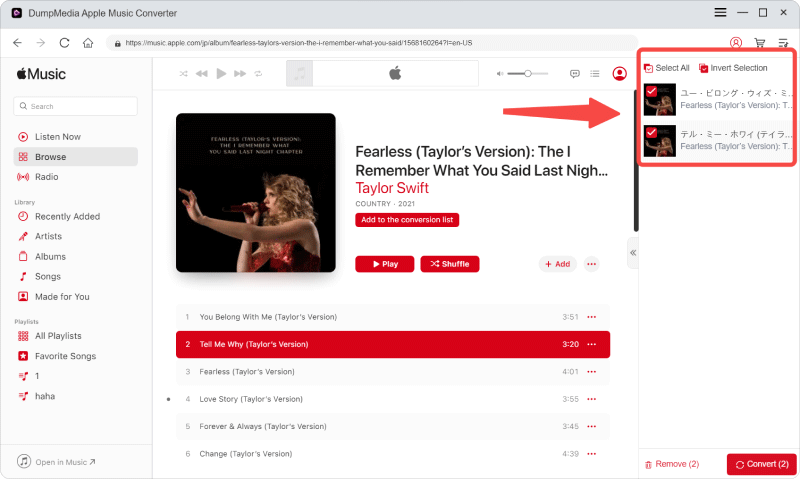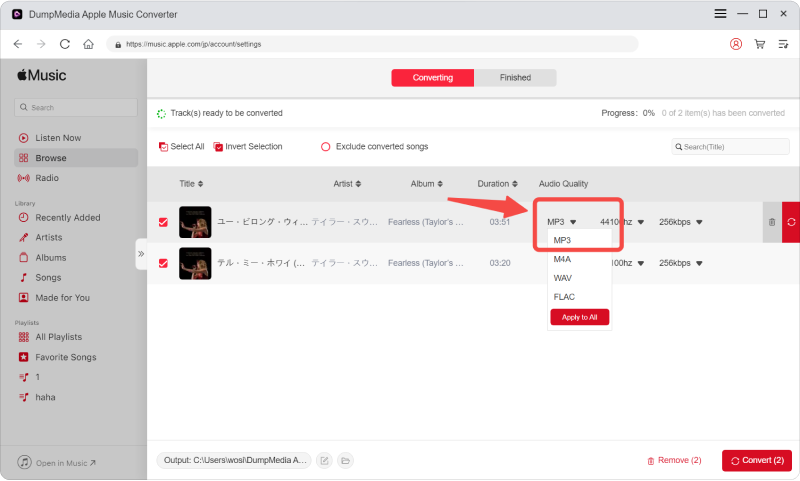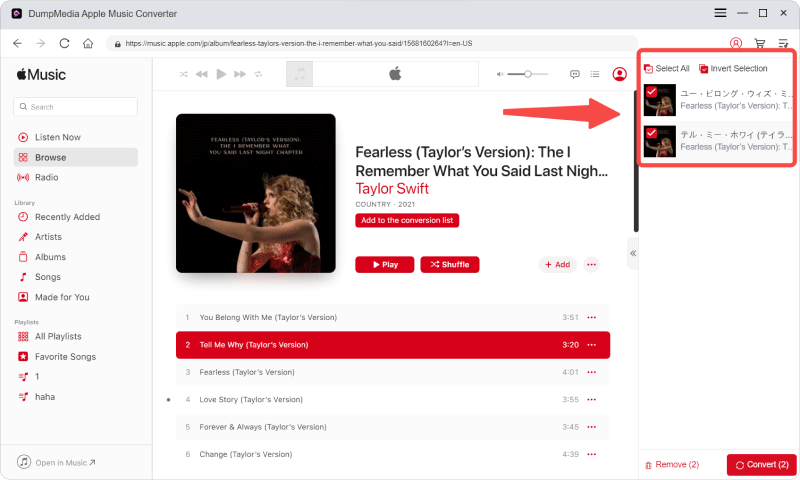
In the realm of high-quality audio, FLAC (Free Lossless Audio Codec) has long been cherished by audiophiles for its ability to deliver uncompromising sound reproduction. However, with the rise of Apple's innovative audio technologies, a new contender has emerged to revolutionize the way we experience music: Apple Lossless. In this article, we delve into the transition from FLAC to Apple Lossless, shedding light on the benefits and features of Apple's cutting-edge codec.
Apple Lossless, also known as ALAC (Apple Lossless Audio Codec), represents a breakthrough in audio compression, offering a formidable alternative to FLAC. Renowned for its seamless integration with Apple's ecosystem, Apple Lossless provides music enthusiasts with a means to enjoy audiophile-grade sound quality across a wide range of Apple devices, from iPhones and iPads to Mac computers and Apple TVs.
In this journey from FLAC to Apple Lossless, we explore the underlying technology behind Apple's codec, examining its compression algorithms and how it maintains the integrity of the original audio source. We'll also discuss the advantages of Apple Lossless over FLAC, including its compatibility with popular Apple software such as iTunes and Apple Music, and its support for advanced features like gapless playback and metadata integration.
Contents Guide Part 1. Does Apple Music Tracks Use the Apple Lossless Format?Part 2. FLAC vs. Apple LosslessPart 3. How to Convert FLAC to Apple LosslessPart 4. Best Way To Listen to Apple Music ALAC Tracks: DumpMedia Apple Music Converter
Yes, Apple Music tracks now support the Apple Lossless format, providing users with the option to enjoy their music in pristine, lossless quality. This recent development marks a significant enhancement to the audio experience offered by Apple's music streaming service.
Previously, Apple Music primarily utilized the AAC (Advanced Audio Coding) format for its tracks, which offered a balance between audio quality and file size. However, with the introduction of Apple Lossless, subscribers now have access to an even higher level of audio fidelity.
Apple Lossless, also known as ALAC (Apple Lossless Audio Codec), is a lossless audio compression format developed by Apple. It is designed to preserve the original audio quality of a recording while reducing file size without any loss of information. This means that when you listen to a song in Apple Lossless, you experience the music as it was intended, with all the subtleties, nuances, and dynamic range preserved.
By embracing Apple Lossless, Apple Music raises the bar for audio quality, catering to the discerning ears of audiophiles and music enthusiasts who demand the utmost in fidelity. Whether you're a fan of classical compositions, rock anthems, or intricate jazz performances, Apple Lossless allows you to immerse yourself in the full richness of the music, capturing every detail and sonic subtlety.
It's worth noting that Apple Lossless files are typically larger compared to compressed formats like AAC. Therefore, if you choose to enable the Apple Lossless option in Apple Music, it may require more storage space on your device. However, the increased file size is a trade-off for an unparalleled listening experience that remains true to the original recording.
To take advantage of Apple Lossless in Apple Music, you'll need a compatible device and the latest version of iOS, iPadOS, macOS, or tvOS. Additionally, Apple Lossless is available to Apple Music subscribers at no additional cost, making it an enticing option for those seeking the highest quality audio playback.
In summary, while Apple Music previously utilized the AAC format, it now supports Apple Lossless, enabling subscribers to enjoy their favorite tracks in a pristine, lossless quality. This enhancement elevates the audio experience for Apple Music users, providing them with an opportunity to savor their music collection with unparalleled fidelity and immersion.
FLAC (Free Lossless Audio Codec) and Apple Lossless (ALAC) are both lossless audio formats that aim to deliver high-quality sound reproduction. Let's compare these two formats to understand their similarities and differences.
FLAC: FLAC employs a robust compression algorithm that reduces file size without compromising audio quality. It achieves compression ratios of about 50-60%.
Apple Lossless: Similar to FLAC, Apple Lossless also utilizes an efficient compression algorithm to shrink file size while retaining audio integrity. It achieves compression ratios of approximately 40-50%.
FLAC: FLAC is widely supported across various platforms, including music players, operating systems, and streaming services. It is a non-proprietary format that offers broad compatibility beyond the Apple ecosystem.
Apple Lossless: Apple Lossless is specifically designed for seamless integration with Apple devices, software, and services. It is natively supported on iOS, macOS, and other Apple platforms, providing a cohesive experience within the Apple ecosystem.
FLAC: FLAC files can be played on a wide range of devices, including smartphones, tablets, computers, and dedicated audio players. Numerous third-party apps and software support FLAC playback.
Apple Lossless: Apple Lossless is primarily compatible with Apple devices, such as iPhones, iPads, Macs, and Apple TVs. It integrates smoothly with Apple's ecosystem and works seamlessly with Apple Music and iTunes.
FLAC: FLAC supports robust metadata tagging, allowing users to embed detailed information about the audio file, such as artist, album, and track information. It also supports advanced features like cue sheets and embedded album art.
Apple Lossless: Apple Lossless supports comprehensive metadata tagging and is well-integrated with Apple's ecosystem, enabling features like gapless playback, AirPlay streaming, and Siri voice control.
FLAC: FLAC is widely available and accessible, with a vast library of music in FLAC format available for purchase or download from various online sources and music stores.
Apple Lossless: Apple Lossless is predominantly associated with Apple's services, including Apple Music, iTunes, and the iTunes Store, offering a vast catalog of tracks in the format.
In summary, FLAC and Apple Lossless are both lossless audio formats that excel in preserving audio quality. FLAC offers broader compatibility across platforms, while Apple Lossless provides seamless integration within the Apple ecosystem. Your choice between the two formats may depend on your preferred devices, software, and the ecosystem you are most invested in.
When it comes to converting FLAC files to Apple Lossless, there are several tools available, including both online and offline options. One highly recommended free online tool for converting FLAC to Apple Lossless is CloudConvert.
CloudConvert is a versatile online file conversion service that supports a wide range of audio and video formats, including FLAC and Apple Lossless. It provides a user-friendly interface and offers a seamless conversion process. Here's a step-by-step guide on how to use CloudConvert to convert FLAC to Apple Lossless:
CloudConvert offers a reliable and convenient solution for converting FLAC files to Apple Lossless without requiring any software installation. It ensures the integrity of the audio content and delivers high-quality output in the desired format.
Remember to exercise caution when using online file conversion tools and ensure that your FLAC files are obtained from legitimate sources to avoid any potential copyright infringements.
Note: While CloudConvert is a recommended online tool, there are alternative options available, such as desktop software and other online converters. Feel free to explore different tools based on your specific requirements and preferences.
When it comes to listening to Apple Music ALAC tracks outside of the Apple ecosystem, one highly regarded solution is the DumpMedia Apple Music Converter. This software provides a powerful and efficient way to convert and enjoy your Apple Music ALAC tracks on various devices and platforms.
DumpMedia Apple Music Converter is designed to convert Apple Music ALAC tracks to a variety of popular audio formats, such as MP3, FLAC, WAV, and more. This allows you to enjoy your favorite songs on any device or music player, even those that do not support the ALAC format.
The software retains important metadata, including song titles, artists, album information, and artwork, during the conversion process. This ensures that your music library remains organized and visually appealing, even after the conversion. The steps to use the tool are as follows:



DumpMedia Apple Music Converter empowers you to enjoy your Apple Music ALAC tracks on a wide range of devices and platforms, expanding your listening options beyond the Apple ecosystem. Whether you want to listen to your favorite songs on non-Apple devices, car audio systems, or other media players, this software provides a convenient and effective solution.
